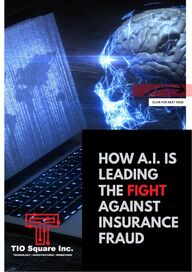
Return to flip book view
HOW A.I. ISLEADINGTHE FIGHTAGAINSTINSURANCEFRAUD Click For Next Page
According to the FBI, thetotal cost of insurancefraud (excluding healthinsurance) is estimated tobe more than $40 billionannually in the US. This number is set to increase in the upcoming years. While identifying insurance fraud wasonce a time-consuming, arduousprocess for claims professionals, theemergence of multiple A.I. (artificialintelligence) technologies is making itquicker and easier for insurancecarriers to detect signs of fraudulentclaims. A.I. applications are now beingdeveloped to specifically spot signs offraud.How can A.I. help withdetecting fraud? With a multitude of state-of-the-art A.I.tools to choose from, insurers don’tneed to go through the sameresource-draining, costly and tediousprocedures they once relied on whilereviewing claims. With the advent ofA.I., the entire process is automatedand simplified through the use of dataanalytic tools and predictive models. www.tiosq.com
WHAT CANDATA DO FORINSURANCEFRAUD? By using data analysis acrossmultiple internal and externalchannels within your company, youcan cross-reference data pointsthat help identify fraudulentbehavior patterns. Deep trends and analysis of Big Data is nearlyimpossible for a human to processquickly without progressivetechnologies designed to reviewthe information at scale. One example of cross-referencingdata would be comparing a newclaim to the existing dataset youhave on one or multiple subjects,or a time of year when certaintypes of claims peak for one reasonor the next. With the use of A.I., you can beinformed of claims that exhibit typical characteristics of fraud,before a member of your teamever initiates an investigation.However, it’s not as simple asfeeding your entire system datapoints and receiving the answer toa fraudulent claim. Instead, acomplex combination of fraudtechniques is usually fed into theA.I. program to help insurersidentify opportunistic, organized,or intentional fraud.Is A.I. new to the insuranceindustry? No. Not at all. If you are activelyworking within the insurance industry,you are likely already using multiplechannels of A.I. to complete part ofyour work, especially in terms ofunderwriting, marketing, and productdevelopment. It is also commonlyused to compare and match prices sothat premiums are competitivelypriced. That’s why exploring A,I, in relation tofraudulent claims does not mean youneed to overturn or disrupt thesystems you have right now. Instead,you should view it as a means toimprove your fraud detection by usingexisting systems, rather than startingfrom scratch. www.tiosq.com
WHAT CANA.I. FLAG? A.I. can help flag manydifferent yet commonfraud-related activities. In other cases, it can drawattention to new patternsthat are emerging, whichcurrent programs are notyet aware of. Network AnalysisBy using A.I. to draw connectionsbetween people and events, youcan seek out fraud ringparticipants that may beconnected, or share outsideconnections. Unsupervised MachineLearningThis type of A.I. doesn’t follow therules of traditional programming.This makes it hard for fraudstersto know what specific patternsinsurers are looking out for andhence, cannot avoid suspiciousbehavior detection. You arealways one step ahead. Speech recognitionSpeech A.I. can analyze andrecognize certain word patternsand triggers that may highlightfraudulent behavior, flagging theclaim before it progresses. Image recognitionA.I. apps can identify whether theprovided image of a subjectmatches the insured's providedimage. This helps preventinstances of identity theft, anduncover fraud rings. Web crawlingMost individuals maintain a webpresence. The use of A.I. for webcrawling focuses on data mining,to analyze massive amounts ofdata across the internet,especially on social media sites. SOME EXAMPLES INCLUDE: www.tiosq.com
COMBINING A.I. WITH OPENSOURCE INTELLIGENCE (OSINT)In the past, OSINT was mostlycomprised of foreign and local newssources in order to put together aprofile of an individual. This information was analyzed to gaina broader picture of already availableinformation. It was often used toconfirm a fact, rather than minedifferent sources of data from whichto build a case. With the magnitude of OSINT datasources available now, due to thedigital revolution, OSINT researchencompasses a wealth of onlinechannel and networks - from publiclegal records to news stories, personalsocial media channels, to connectionswithin the dark web, in order tooutput a comprehensive digitalfootprint of the individual. To keep on top of OSINT, thereneeds to be 24/7 monitoring, whichis only feasible through A.I.automation. A.I can work through tremendousamounts of information to identifypotential risks, flag potential fraud, orat least draw our attention tosuspicious data for further evaluation. The pace at which A.I. works throughdata is something none of us haveseen in the past, and it would beimpossible for even a large group ofhumans to keep up with. Furthermore, this analysis works inreal-time, without lags or setbacks.This speeds up the process ofidentifying suspicious behavior, fromthe moment it occurs, and onward. By using A.I., you also reduce thenumber of errors that occur in such ananalysis, and free up an analyst’sprocessing time, so they can activelynavigate what to do next. In short, A.I.-powered OSINT can beleveraged to assess pretty much anysituation, communication, orinteraction as it happens, to help flaginstant connections about suspicious,threatening, or fraudulent behavior. www.tiosq.com
CONCLUSIONA.I. is revolutionizing the insuranceindustry by enhancing frauddetection efforts, it is being used toflag suspicious behavior, and fordeveloping predictive models thatcan swiftly identify signs of potentialfraud before it ever occurs. If your company is consideringleveraging A.I. and other technologybreakthroughs in order to gain keyinsights into subjects of investigation,now is the time to consult with alicensed Investigation agency thatspecializes in technology. Are you interested in learningmore? CONTACT US TODAY(866) 690-0977www.tiosq.cominfo@tiosquare.com
www.tiosq.com(866) 690-0977